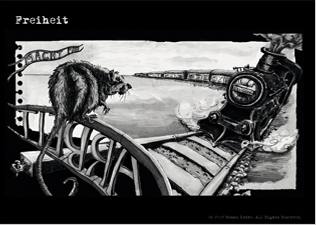Fine-Art „Giclée“-Print on canvas – stretched over a wooden frame with a depth of 2 cm
Illustration by Roman Kroke (2009)
Mesures: 40 cm x 30 cm
Customized title: language freely selectable – please specify the language of your choice during the order (in the preview: French)
Annotations to the illustration by Roman Kroke:
I created the illustration on the basis of the following citations from Etty’s diary:
“If you have a rich inner life, I would have said, there probably isn’t all that much difference between the inside and outside of a camp. Would I myself be able to live up to such sentiments? There are few illusions left to us. Life is going to be very hard. We shall be torn apart, all who are dear to one another. I don’t think the time is very far off now. We shall have to steel ourselves inwardly more and more.“
12 March 1942
“Many who are indignant about injustices are indignant only because the injustices are being inflicted on them. Their indignation is skin-deep. In a labour camp I should die within three days. I should lie down and die and still not find life unfair.”
4 July 1942
The illustration shows the arrival of the deportation train in the concentration camp at Auschwitz-Birkenau. You can still find the wrought iron writing “ARBEIT MACHT FREI” (= “working makes (you) free”) over the entrance to the camp. A closer observation of the letters reveals that the “B” in “ARBEIT” (= “work”) is upside down – the big bulge of the letter is at the top, the little one at the bottom. According to the information provided by the Museum Auschwitz-Birkenau the letters were manufactured by political detainees in the camp who expressed a camouflaged act of resistance. With the inverted “B”, they intended to display the absurdity and the lie behind the message. The “B” remained unchanged! A tiny space left for his personal protest against the inhumanity of the system.
The railway line that leads into nothingness and blackness stands, once again, for the way leading to death. It continues the symbolism already introduced in the illustration “Travel Eastward”.
Etty repeatedly compares the circumstances they are living in with those of rats. I also integrated the symbol of the rat into the illustrations “Travel Eastward” and “Thinking Heart”.
